These are my first curving chisel lines, under the direction of Julio:
This is an experiment in inlaying silver into copper:
Here I am texturing a project of copper in steel that I never finished:
But alas, I had to move on. I said farewell to Julio and his wife Annabel, with many thanks and a determination to provide them with the same sort of hostly generosity another day.
So on I trudged, north and east, into the elder Kingdom of East Anglia, and the ancient city of Colchester (Roman Camelodunum)! Here I was hosted by another good friend, Anthony, who worked at a pub called The Hole in the Wall, where an actual hole in the wall revealed sections of the Roman wall built there about two millenia beforehand. Feet away from that wall we enjoyed pints of Hobgoblin and existential conversation over games of pool.
 |
| The heathen Britons approach! |
East Anglia: an ancient realm, where the land still hums with the intoxicating spirit of Anglo-Saxon enterprise, the sentiment of "I have a sword and a ship and I can take what I want". I'll touch on it more later, but to me this is a fascinating embodiment of the sword as will, and the idea of an armed man as a decider, and a doler of mercy and violence as he sees fit.
The spirit is palatable here, at the burial mounds of Sutton Hoo, where I saw one of the most incredible sunsets of my life. The museum was fascinating, the information illuminating. But there was something about standing in the wind in a bleak farm-field, alone before the mounds of kings who carved their kingdom from nothing, in a world where they took what they wanted and built what they would.
My next stop after Colchester was York, ancient Jórvík, first the seat of Northumbrian kings and later of the Danish vikings. I arrived in time for the annual York Viking Festival, a massive and captivating festival, full of re-enactors and vendors and educational events, and just overwhelmingly fun. Witness battle:
Mr. James Cameron, student of Welsh gravestones, as well as a Saxon warrior who keeps up to date with the Danegeld on his iPhone:
Irresistible architecture of the city:
Vendors inside the above building who introduced me to the wonders of tablet weaving:
This woman let me try it out, and I'm still planning on doing some of it myself!
The fabulous pattern-welded blades of Łukasz Szczepański, sold by his friend Dariusz (Nordulf jewellery), member of the fantastic group Wulfheodenas!
But once again, it was time to move north.












Good
ReplyDelete